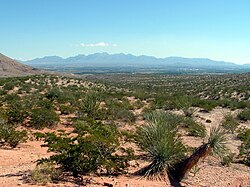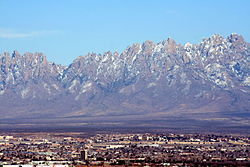| This article needs additional citations for verification. Please help improve this article by adding citations to reliable sources. Unsourced material may be challenged and removed. Find sources: "Mesilla Valley" – news · newspapers · books · scholar · JSTOR (February 2013) (Learn how and when to remove this message) |


The Mesilla Valley is a geographic feature of Southern New Mexico and far West Texas. It was formed by repeated heavy spring floods of the Rio Grande.
Background
The fertile Mesilla Valley extends from Radium Springs, New Mexico, to the west side of El Paso, Texas. The valley is characterized by its few remaining bosques, as well as its native cottonwood trees, and increasingly, by invasive tamarisk, which was introduced in the late 19th century, and is known locally as salt cedar.
Due to the fertile nature of the valley, agriculture is a very important activity in this area. Stahmann Farms owns the world's largest pecan orchard, located south of the city of Las Cruces, New Mexico. Alfalfa, cotton, chile, onions and corn are other important cash crops grown in the Mesilla Valley. The Mesilla Valley is also known for its wine-producing capabilities, which originated with the Spanish exploration into New Mexico. It was part of Mexico until Gadsden Purchase in 1853.
Further reading
- Leggat, E.R., M.E. Lowry, and J.W. Hood. (1963). Ground-water resources of the lower Mesilla Valley, Texas and New Mexico . Washington, D.C.: U.S. Government Printing Office.
References
- Chang, C. W. (1953). "Chemical Properties of Alkali Soils in Mesilla Valley, New Mexico". Soil Science. 75 (3): 233–242. doi:10.1097/00010694-195303000-00008.
31°47′25″N 106°25′24″W / 31.79028°N 106.42333°W / 31.79028; -106.42333
This New Mexico state location article is a stub. You can help Misplaced Pages by expanding it. |